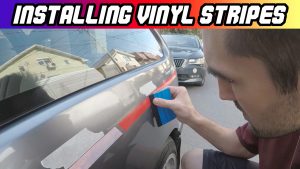How to Properly Bed In New Car Brake Pads & Rotors
In this video I will show you the process of bedding in new brake pads and discs when you have installed new brake pads and rotors on your car. This process applies whether you have installed new rotors and pads or just new pads.
Why Bed In New Brake Pads?
When you first install new brake pads, they don’t match the brake rotor 100%. This is because the items are manufactured individually, and as a result, the brake pad surface won’t be fully contacting the rotor when new.
As well as this, when you bed in brake pads, some of the brake pad material actually gets transferred onto the rotor, which aids in the stopping performance of your pads. This is because brake pads grabbing onto pure metal don’t actually work that well, they need to grab onto another grippy surface – brake pad material – in order to stop effectively.
Due to all this, the brakes will not work at their optimal performance until the brake pads have been “bedded-in” to the rotor, and the surfaces match 100%, giving the pad complete contact on the rotor and allowing it to grip with its full surface area.
Now, brake pads will naturally bed in during normal day to day driving. However, to minimize any potential issues and ensure your brake pads perform 100% right away, bedding them in is a good idea and doesn’t take long.
It’s also a good way to test your braking system and insure everything has been installed and is working correctly.
What Happens If You Don’t Bed In New Brake Pads?
As mentioned earlier, brake pads can naturally bed themselves in during normal day to day driving. However, if the brakes are used to hard too early (such as an emergency stop right after being installed) and then the car is parked, the brake pads can transfer too much material onto the rotor due to the heat (pretty much welding themselves to the rotor), which will result in an uneven surface on the rotor.
The end result of this will be a rotor that causes vibrations in the steering wheel, often diagnosed as a “warped rotor” which most of the time means you now have to replace the brake rotors again with new ones.
Also, if you are relying on natural driving to bed the brake pads in, you’ll notice that your brakes don’t work as well for a while until they have bedded themselves in. If you need to do an emergency stop, you may find yourself with substandard brakes that don’t stop your car in time.
This can be avoided by doing the proper bedding in procedure which will allow you to use your brakes properly as soon as you are done, so you won’t have to worry about something like this happening.
The Process of Bedding In New Brake Pads And Rotors
Every manufacturer of brakes will recommend a slightly different procedure, however this process I’m going to show you here will cover most brake pads (unless you are running trackday pads or some other specialist pads – then follow the instructions that came with them).
What you need to do is find an empty bit of road (straight if possible) that you can safely stop on. So make sure there are no other cars around.
You will need to do series of stops from successively higher speeds.
First, you want to do 5-10 stops from 50kmh (30mph) down to about 10kmh (around 7mph). Do NOT brake hard enough to activate the ABS or lock up the tyres. It should be firm but smooth, and you’ll take a few seconds to come down to the slower speed – that is normal.
Next, you want to do 3-5 stops from 80kmh (50mph) down to 10kmh (7mph). Same as before, do not brake hard to activate the ABS or lockup the tyres.
At this point you’ll probably notice that the brakes aren’t working great and you need to push the pedal further for them to bite.
Now you’ll need to let the brakes cool off.
NOTE: At this point make sure to not use the brakes hard or do any emergency stops (unless there is an actual emergency). If you come to a traffic light or a stop, DO NOT sit of the brake pedal, always lift off. If you sit on the brakes, you can get bits of brake pad stuck to the the rotor, which will cause vibrations in your steering wheel and you’ll need to get new rotors (as described earlier).
Try to keep the car moving but take it easy and stay off the brakes as much as possible. Do this for about 10 minutes.
Once that’s done, pull over to the side of the road and let the brakes fully cool. DO NOT put your handbrake up – it can seize on from the heat. Just put the car in park or in gear and let it cool down for about 15 minutes.
That’s it. Now your new brakes are ready to be used.
- BC Racing BR Series VS Tein Flex Z Coilovers - April 15, 2024
- The Pros and Cons of Shock Body Vs Spring Perch Coilover Height Adjustment - April 13, 2024
- Monotube Vs Twin Tube Shocks: The Ultimate Guide - April 11, 2024



